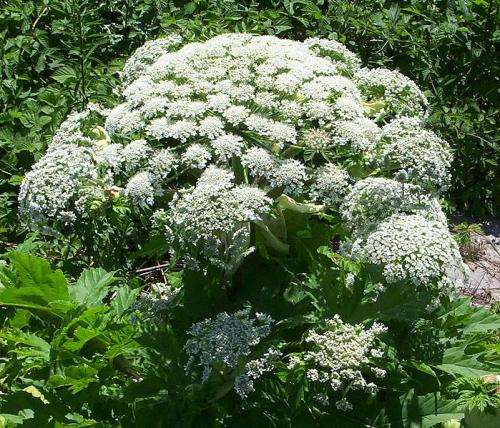July 11, 2011 report
Giant hogweed can cause burns and blindness

(PhysOrg.com) -- The U.S Department of Agriculture is warning residents in a variety of states to be on the lookout for the Heracleum Mantegazzianum, or giant hogweed. This plant in native to Central Asia but has turned up in numerous states within the U.S. and can cause burns, blisters and blindness.
Jodi Holt, a professor of plant physiology from the University of California warns that the plant should be avoided at all costs. The giant hogweed can grow up to 15 feet tall and has umbrella-size flowers. These flowers contain a toxic sap that contains a photosensitizing chemical that causes phytophotodermatitis.
When the sap comes in contact with human skin, a reaction can occur within 15 minutes, especially when the person is in direct sunlight. The chemical essentially accelerates sun damage and results in serious sunburn which can blister and cause scars and skin pigmentation. If the sap comes in contact with the eyes, blindness can occur. Reports of blindness have occurred when young children have played with the plants hollow stalks as telescopes.
The U.S Department of Agriculture has placed the giant hogweed on its Federal Noxious Weed list. The plant has been reported in a number of states including Connecticut, Maine, Maryland, Massachusetts, New Hampshire, New York, Pennsylvania, Vermont, Michigan, Ohio, Oregon and Washington.
Experts advise that if you spot a giant hogweed, do not try and remove it yourself. Contact your local or state department of invasive species control and report the sighting. States are working on efforts to remove and destroy the giant hogweed.
New York State has gone so far as to create a giant hogweed hotline at 845-256-3111 and asks that all residents call this number to report a sighting of the giant weed.
Crews throughout the reported states have been set up to locate and destroy these weeds. Large patches of the weeds require a large amount of herbicides while areas with smaller patches or singular plants can be destroyed by cutting the root system.
Just as residents living with poison ivy or poison oak have learned to identify the plants, experts recommend everyone in the affected states learn to identify these weeds and avoid coming into contact with them.
© 2010 PhysOrg.com

















